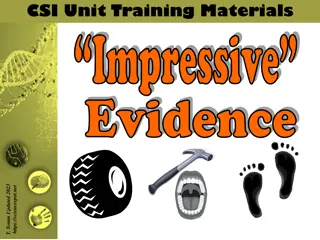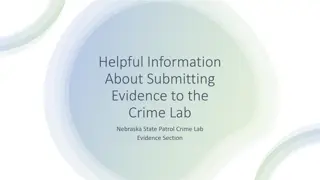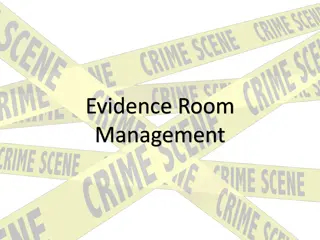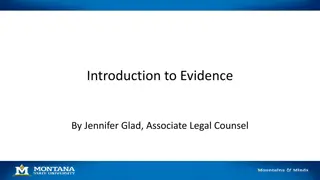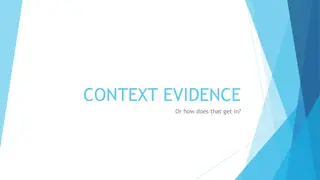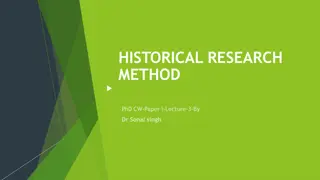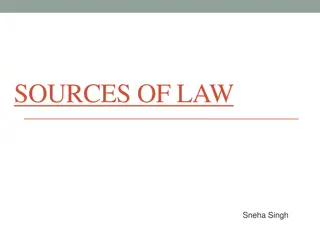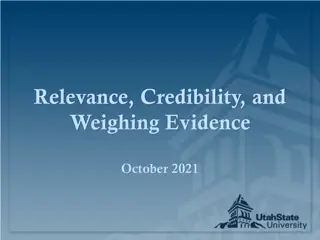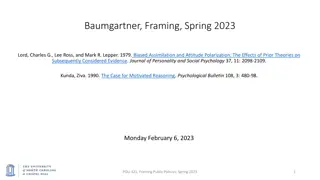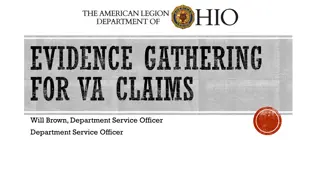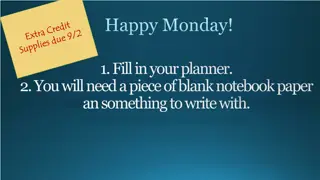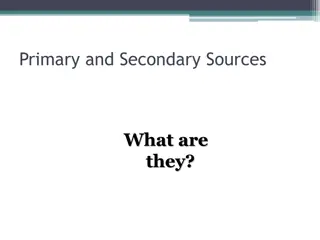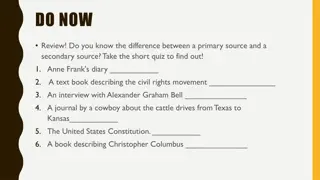Historical Sources as Evidence
Explore the importance of historical sources as evidence in the Victorian Curriculum History context, focusing on how students analyze, evaluate, and utilize sources to create historical explanations and arguments. Discover the significance of primary and secondary sources, perspectives of historical actors, and the process of exploring historical viewpoints.
Download Presentation

Please find below an Image/Link to download the presentation.
The content on the website is provided AS IS for your information and personal use only. It may not be sold, licensed, or shared on other websites without obtaining consent from the author.If you encounter any issues during the download, it is possible that the publisher has removed the file from their server.
You are allowed to download the files provided on this website for personal or commercial use, subject to the condition that they are used lawfully. All files are the property of their respective owners.
The content on the website is provided AS IS for your information and personal use only. It may not be sold, licensed, or shared on other websites without obtaining consent from the author.
E N D
Presentation Transcript
Historical Sources as Evidence Levels 7 to 10
Introduction Provocation Historical Sources as Evidence in the curriculum context Historical Sources as Evidence in Victorian Curriculum History Historical Sources as Evidence in the continuum of learning Towards the classroom Examples of practice Conclusion
A trace of the past that is left behind by accident the detritus of everyday life that just happened to be preserved. Traces are not organised as stories, that is, as accounts of a situation; their authors did not intend to provide one. But they do form the material for historians to write theirs. Peter Seixas & Tom Morton, The Big Six Historical Thinking Concepts
Historical Sources as Evidence in Victorian Curriculum History
Victorian Curriculum History Learning in History Achievement Standard Skill/Concept Historical Knowledge
Learning in History Using historical sources as evidence, students are required to ask analytical and evaluative questions of the sources so they can be used as evidence when creating historical explanations and constructing historical arguments. Students identify the origin, content features, and purpose of sources. They learn to explain the context of sources, corroborate (compare and contrast) them with other sources and make judgments about their accuracy, usefulness and reliability. Historical questions about sources could include: What type of source is this? Who wrote or created it? Why did they write or create it? What was happening at the time the source was created? Who was the intended audience? How does it compare with other sources about the same person or event? How accurate is this source? Victorian History Curriculum, Learning in History: Using Historical Sources as Evidence
The building blocks of historical thinking Created at the time of the event or shortly afterwards May be visual, written, audio, audio-visual and artefacts Historical perspectives of those who experienced or witnessed events of the past Primary sources Historical sources Interpretations made by historians or commentators May be textbooks, historical research, documentaries, artworks Often draw on primary sources to present arguments or interpretations of the past Historical interpretations Secondary sources Students: understand historical perspectives through exploring the point of view, attitudes, values and beliefs of people in the past consider the thoughts, feelings and reasons for action of people in the past consider the mindsets of historical actors and the ways that context shaped the ways they saw and acted in the world. Exploring perspectives involves the identification and description of the viewpoints of witnesses to events who experienced the consequences or lived with their changes. Exploring historical perspectives Historians provide interpretations of the past based on their own reading of sources. Through questioning interpretations, students understand that different historical interpretations may be open to debate and contestation. Explaining historical interpretations
Achievement Standard Levels 7 and 8 Achievement Standard They locate and select historical sources and identify their origin, content features and purpose. Students explain the historical context of these sources. They compare and contrast historical sources and ask questions about their accuracy, usefulness and reliability. Students analyse the different perspectives of people in the past using sources. They explain different historical interpretations and contested debates about the past. Students construct an explanation using sources of evidence to support the analysis. Levels 9 and 10 Achievement Standard They locate and select historical sources and identify their origin, purpose and content features. Students explain the context of these sources to identify motivations, values and attitudes. They compare and contrast historical sources and evaluate their accuracy, usefulness and reliability. Students analyse the different perspectives of people in the past and evaluate how these perspectives are influenced by the significant events, ideas, location, beliefs and values. They evaluate different historical interpretations and contested debates. Students construct and communicate an argument about the past using a range of reliable sources of evidence.
Historical Concepts and Skills: Historical Sources as Evidence Levels 7 and 8 Analyse and corroborate sources and ask questions about their accuracy, usefulness and reliability (VCHHC099) Levels 9 and 10 Analyse and corroborate sources and evaluate their accuracy, usefulness and reliability (VCHHC123) Analyse the different perspectives of people in the past and evaluate how these perspectives are influenced by significant events, ideas, location, beliefs and values (VCHHC124) Analyse the different perspectives of people in the past (VCHHC100) Explain different historical interpretations and contested debates about the past (VCHHC101) Evaluate different historical interpretations and contested debates (VCHHC125)
Continuum of learning Levels 7 and 8 Levels 9 and 10 Achievement Standard Achievement Standard They locate and select historical sources and identify their origin, purpose and content features. Students explain the context of these sources to identify motivations, values and attitudes. They compare and contrast historical sources and evaluate their accuracy, usefulness and reliability. Students analyse the different perspectives of people in the past and evaluate how these perspectives are influenced by the significant events, ideas, location, beliefs and values. They evaluate different historical interpretations and contested debates. They locate and select historical sources and identify their origin, content features and purpose. Students explain the historical context of these sources. They compare and contrast historical sources and ask questions about their accuracy, usefulness and reliability. Students analyse the different perspectives of people in the past using sources. They explain different historical interpretations and contested debates about the past. Historical Concepts and Skills Historical Concepts and Skills Analyse and corroborate sources and evaluate their accuracy, usefulness and reliability (VCHHC123) Analyse the different perspectives of people in the past and evaluate how these perspectives are influenced by significant events, ideas, location, beliefs and values (VCHHC124) Evaluate different historical interpretations and contested debates (VCHHC125) Analyse and corroborate sources and ask questions about their accuracy, usefulness and reliability (VCHHC099) Analyse the different perspectives of people in the past (VCHHC100) Explain different historical interpretations and contested debates about the past (VCHHC101)
Historical Knowledge: Levels 7 and 8 Aboriginal and Torres Strait Islander peoples and cultures How physical or geographical features influenced the development of Aboriginal and Torres Strait Islander peoples communities, foundational stories and land management practices (VCHHK105) The significant beliefs, values and practices of Aboriginal and Torres Strait Islander peoples and cultures including trade with other communities, causes and effects of warfare, and death and funerary customs (VCHHK106) The nature of sources of evidence about ancient Australia and what they reveal about Australia s ancient past, such as the use of resources (VCHHK107) The importance of conserving the remains of the ancient past, including the heritage, culture and artefacts of Aboriginal and Torres Strait Islander peoples (VCHHK108)
Where does Historical Sources as Evidence intersect with Historical Knowledge? Historical Knowledge: Levels 9 and 10 Australia at war (1914 1945): World War I Causes of World War I, the reasons why men enlisted to go to war, and how women contributed in the war effort (VCHHK139) Significant places where Australians fought and explore their perspectives and experiences in these places (VCHHK140) Effects of World War I, with a particular emphasis on the changes and continuities brought to the Australian home front and society (VCHHK142) Significance of World War I to Australia s international relationships in the twentieth century, with particular reference to the Britain, the USA and Asia (VCHHK143)
Towards the classroom Levels 7 and 8 Students develop a firm understanding of the usefulness of different types of sources and of ways to assess their reliability. This historical thinking concept sits at the very heart of critical thinking; how can you trust what you read or see? Students consider the role of bias or perspective in the creators of primary sources, and the role of interpretation in the creators of secondary sources. At Levels 5 and 6, students were asked to identify the origin, features and purpose of historical sources. At Levels 7 and 8, they progress to analyse and corroborate sources and ask questions about their accuracy, usefulness and reliability . This is an important shift. This is the level where they begin to apply critical thinking to their study of history. At this level, students also move from describing the perspectives of those who created the primary sources to analysing the perspectives. How did the person s beliefs or values influence the contents of the image or text? Students begin to engage with the notion of contested debates in history they learn that contestation over time leads to greater accuracy and understanding but never to a final or complete account.
Towards the classroom Levels 9 and 10 Students should move to evaluating a source s accuracy, usefulness and reliability. This requires the application of their own judgment and bringing their broader knowledge of the period and events to that task. Students are asked to evaluate how the perspectives of people in the past were shaped by their contexts and beliefs. They are asked to evaluate different historical interpretations by historians and commentators. These higher order skills require a deeper knowledge of the people and events being studied. Informed judgment can only emerge after considering a broad range of information and sources.
Indicative examples By the end of Level 8: students can make reasoned judgments about a source's reliability and usefulness students can explain different perspectives of people in the past through the analysis of historical sources students can explain what different historians have said about a particular historical event or development. By the end of Level 10: students can make informed judgments about a source's reliability and usefulness students can explain varying perspectives of people in the past through the analysis of historical sources students can evaluate what different historians have said about a particular historical event or development.
Questions for using historical sources as evidence How do we learn about societies where very little material culture remains (e.g. Sparta or Ancient Australia)? Why is it important to corroborate evidence? Why can t we just use one source to write about a society? How do the feelings, beliefs, ideologies or values of chroniclers of the past impact how we should read and understand sources? Why do historians disagree about what happened in the past, even if they are using the same sources?
Language of Historical Sources as Evidence Primary source Secondary source Analyse Corroborate Origin Features Artefact Purpose Context Reliability Ideas, beliefs and values Audience Perspective Interpretation Analysis
Classroom ideas Levels 7 and 8 Create an infographic of historians interpretations of a specific event. Analyse historical sources and produce a written reflection on the perspectives being presented. Identify missing perspectives from given sources. Levels 9 and 10 Create an infographic that evaluates different historians' interpretations of a historical event or development. Analyse historical sources to identify the perspectives of various groups. Compare the interpretation of multiple sources.
Example of practice Levels 7 and 8
2 Activity Key question: How do we know about what happened during the Spanish conquest of the Americas? Activity: Present the information in the following slides. Refer to Levels 7 and 8: Historical Sources as Evidence Student Handout for questions and student activities.
3 Using Historical Sources as Evidence
4 How do we know about what happened during the Spanish conquest of the Americas?
5 Creator of the source: Date created: Title and/or subject: Location: Type of Source: written, visual, audio Is it a primary or secondary source? Explain why. You can use a table like this one to evaluate and analyse a historical source. Whose perspective of the event(s) depicted is shown in the source? Give evidence for your answer. What was the intent of the creator of the source? Why do you think this?
6 Source 1: An oil sketch of the Landing of Columbus in the Rotunda of the United States Capitol by John Vanderlyn, c. 1842
7 Source 2: The Conquest of Tenochtitlan, from the Conquest of Mexico series, late 17th century; unknown artist
8 Source 3: Cortes and his advisor, La Malinche, meet Moctezuma in Tenochtitlan, 8 November, 1519
9 Source 4: Indigenous peoples suffering from smallpox
10 Source 5: Spaniards disposing of the bodies of Moctezuma II (emperor of the Aztecs) and Itzquauhtzin (King of the Nahua.
Example of practice Levels 9 and 10
2 Context When students begin to evaluate sources and make judgments about their reliability, accuracy and usefulness, they should feel the excitement of being detective-historians. Questions of motivation, perspective, ideology, purpose and propaganda become paramount. Is the source accidental, such as a shopping list or someone appearing in the background of an unposed photograph? Or is it deliberate, such as a manifesto or a parliamentary bill? Is there a debate among historians about the events or their significance? How can this disagreement be explained when they have access to the same sources? After considering the evidence, where would the student position themselves within the debate? The following slides contain a sample activity that illustrates one way of approaching Using Historical Sources as Evidence at this level.
3 Activity Key question: How can we use sources to develop a better understanding of the First World War? Activity: Present the information in the following slides. Refer to Levels 9 and 10: Historical Sources as Evidence Student Handout for questions and student activities.
4 Using and evaluating primary source evidence from World War I Australian soldiers at Ypres, 1917
5 Use the 5 Ws to help you examine and evaluate a historical source Activity
6 Were they directly involved in the events? Who created the source? Who? Did they show bias or have a clear opinion? Who was it made for?
7 What Is it information is given? accurate? What? Is it factual or an opinion? Is it the full story?
8 Why was the source created? Why was it kept or preserved? Why? Was it made to inform or persuade? Was it made to record or report?
9 Was the creator there at the time? Was it created at the time? When? Was the creator informed by someone who was there at the time? If it was made later, why was it made then?
10 Did where it was created affect the creator s perspective? Where was it created? Where? Was the creator physically present at the event? Where was it kept or preserved?
11 Author/ creator Validity Date created You may not be able to answer all of these questions about the source, but make sure that you consider: Motivation Meaning Context Audience Purpose Bias
12 Taking source analysis further: written and visual sources Activity
13 War (1932) Evaluate the information Identify the source Out in the dust he lies; Flies in his mouth, Ants in his eyes I stood at the door Where he went out; Full-grown man, Ruddy and stout; Consider the impact of where and when it was created Consider the author and their purpose War by Dame Mary Gilmore, 1932
14 Identify the source Evaluate the information Consider the impact of where and when it was created Consider the artist or commissioner of the artwork and their purpose Australian First World War recruitment poster
Discussion points Do your students see the connection between the skill of evaluating historical evidence and the skill of evaluating fake news ? What kinds of discussions about historical sources might you and your students look for in the media? Is there a historical event or individual being re-evaluated in the light of new evidence or values? Are you choosing more nuanced, subtle and complex sources as students progress through Levels 9 and 10? Have you set aside time in your teaching plan to discuss explicitly with students the more advanced skill of evaluating sources? What kind of incursion, excursion or interactive experience could you design to support the teaching and learning of this concept? How do we design activities that cater for a wide range of learners?
Reflection activity Use the following thinking routine to reflect: I used to think But now I think





